 DoudouLinux
DoudouLinux
The computer they prefer!
 DoudouLinux
DoudouLinux
The computer they prefer!
The site's languages [ar] [cs] [de] [en] [es] [fa] [fr] [it] [ms] [nl] [pt] [pt_br] [ro] [ru] [sr] [sr@latin] [th] [uk] [vi] [zh]

Creating a WiFi hotspot
October 2013All the versions of this article: [čeština] [English] [français] [русский]
DoudouLinux is able to easily setup an ad-hoc network, also called a WiFi hotspot. If you want children to be able to use networking features like chatting or network games but do not want to or cannot connect them to an existing network, this is a simple alternative. You just need to use one of your computers to create the WiFi hotspot then to connect the other computers to the newly created network. The process is explained in detail on this page.
Creating an ad-hoc network
To create a WiFi hotspot, click on the network icon on the top right panel of advanced activities. A menu will be shown and on its very bottom, you will find an entry “Create New Wireless Network…”:
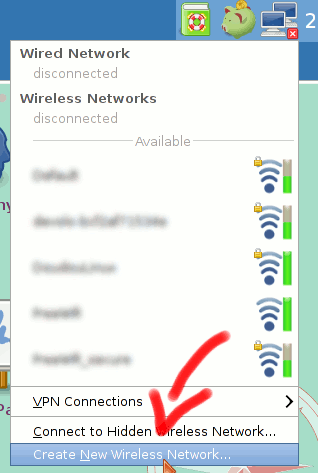
Clicking on this entry will show a small dialog:
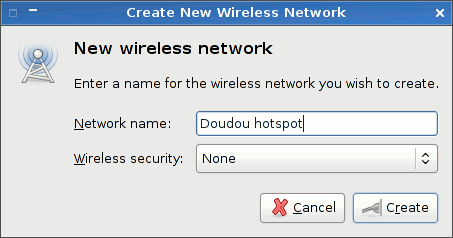
Enter a name for your network, here it is “Doudou hotspot”. You can choose to activate a passphrase to connect to your network, especially if you are in a public area, but this is not mandatory. In this example we created an open network without passphrase. It can be changed afterwards anyway.
When you are done, just click the button “Create”. You will then see the lights on the network icon that show it is running. When the network is active, clicking on the network icon will show you that the current connection is a special connection: the antenna symbol on the left of the WiFi signal symbol indicates that this is an ad-hoc network (see the screenshot below).
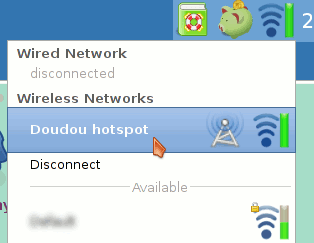
If you want to change some parameters of your network afterwards, you can use the network profile editor. You have to click with the right mouse button on the network icon of the panel. A small menu is shown in which you have to select “Edit Connections…”:
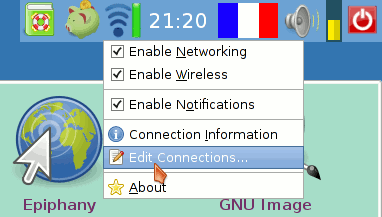
In the dialog window that is shown, choose the tab “Wireless” to find your ad-hoc network profile:
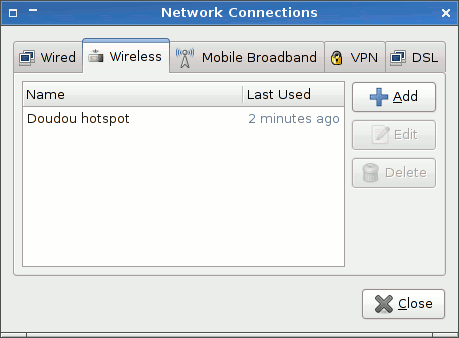
Select your network then choose “Edit”. Another dialog is shown in which you can change parameters of your connection, for example network access control for other computers (“Wireless Security”). You may also be interested in not activating automatic connection, to avoid that a WiFi hotspot is started as soon as no standard network connection is available (cable or wireless). In this case, uncheck the box “Connect automatically” on the top of the window.
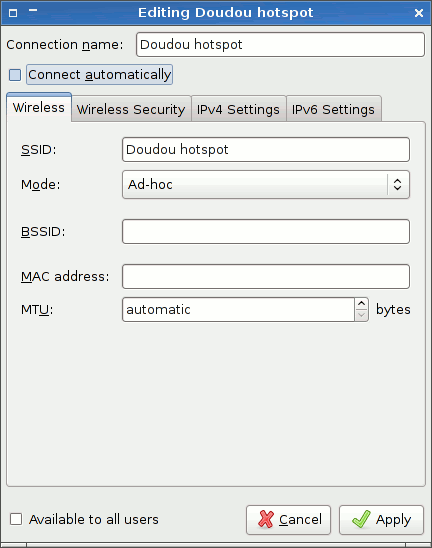
Retrieving a previously created ad-hoc network
If you have already created a WiFi hotspot on your computer, no need to create another one every time you need it. Although this type of network is never listed in the list of the available wireless networks that you get when you click on the network icon of the panel, a previously created network can be retrieved using the entry “Connect to Hidden Wireless Network…” of this menu (see the first screenshot of this page). In the dialog that is shown (see below), just select the name of your ad-hoc network and click “Connect”.
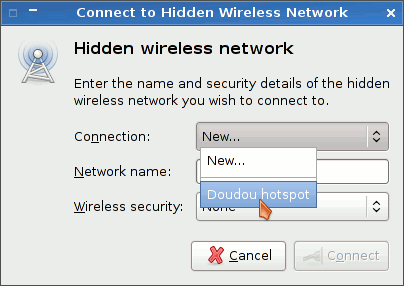
Connecting other DoudouLinux computers
Once the ad-hoc network is running, all the computers around should be able to connect to it. Note that this may take one or two minutes for the network management software to refresh its list of available networks, the new network may then not be available to other computers immediately after its activation.
The ad-hoc network is a bit different from any other wireless network. It is then shown in the list of available networks using the antenna symbol along with the wireless network symbol:
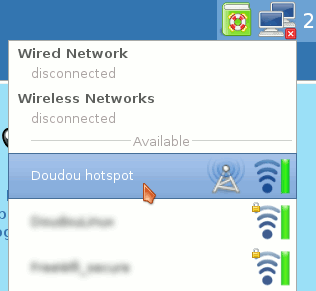
Documentation
-
Applications
-
Configuration
- Mouse setting
- Sound settings
- Screen settings
- Keyboard layout
- Date/time and time zone
- The Activities Menu
- Using a USB key or a USB hard disk
- Using a printer
- Language setting
- Using networking
- Creating a WiFi hotspot
-
Questions and issues
-
Advanced tools
- Preserving user privacy
- Parental controls
- Controlling computer use
- Data persistence
- Creating a DoudouLinux USB key
- Installing DoudouLinux definitively
 Copyright © DoudouLinux.org team - All texts from this site are published under the license
Creative Commons BY-SA
Copyright © DoudouLinux.org team - All texts from this site are published under the license
Creative Commons BY-SA











